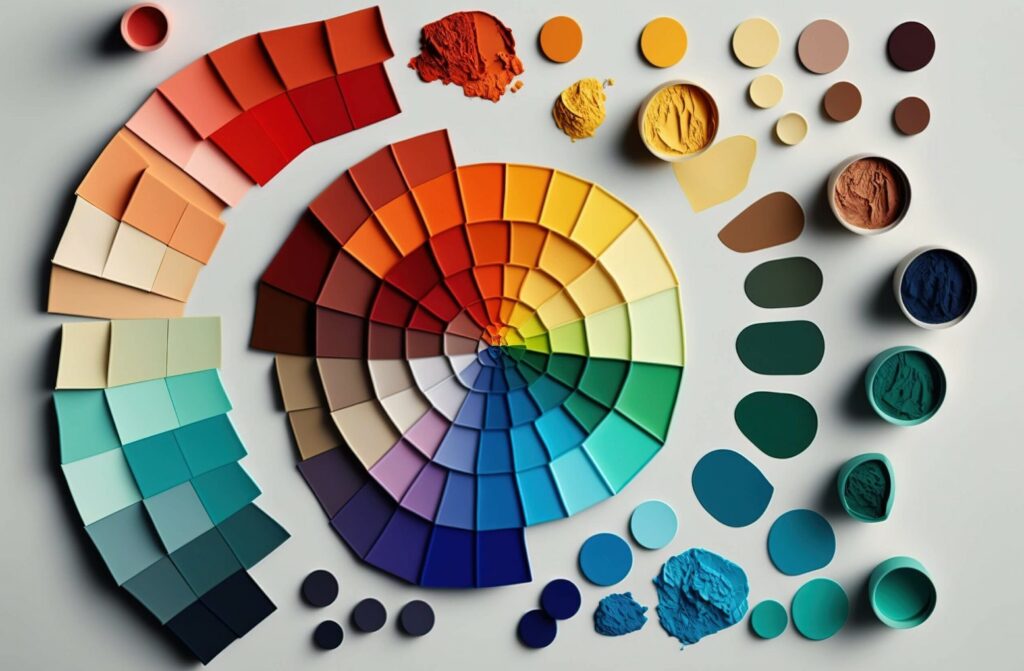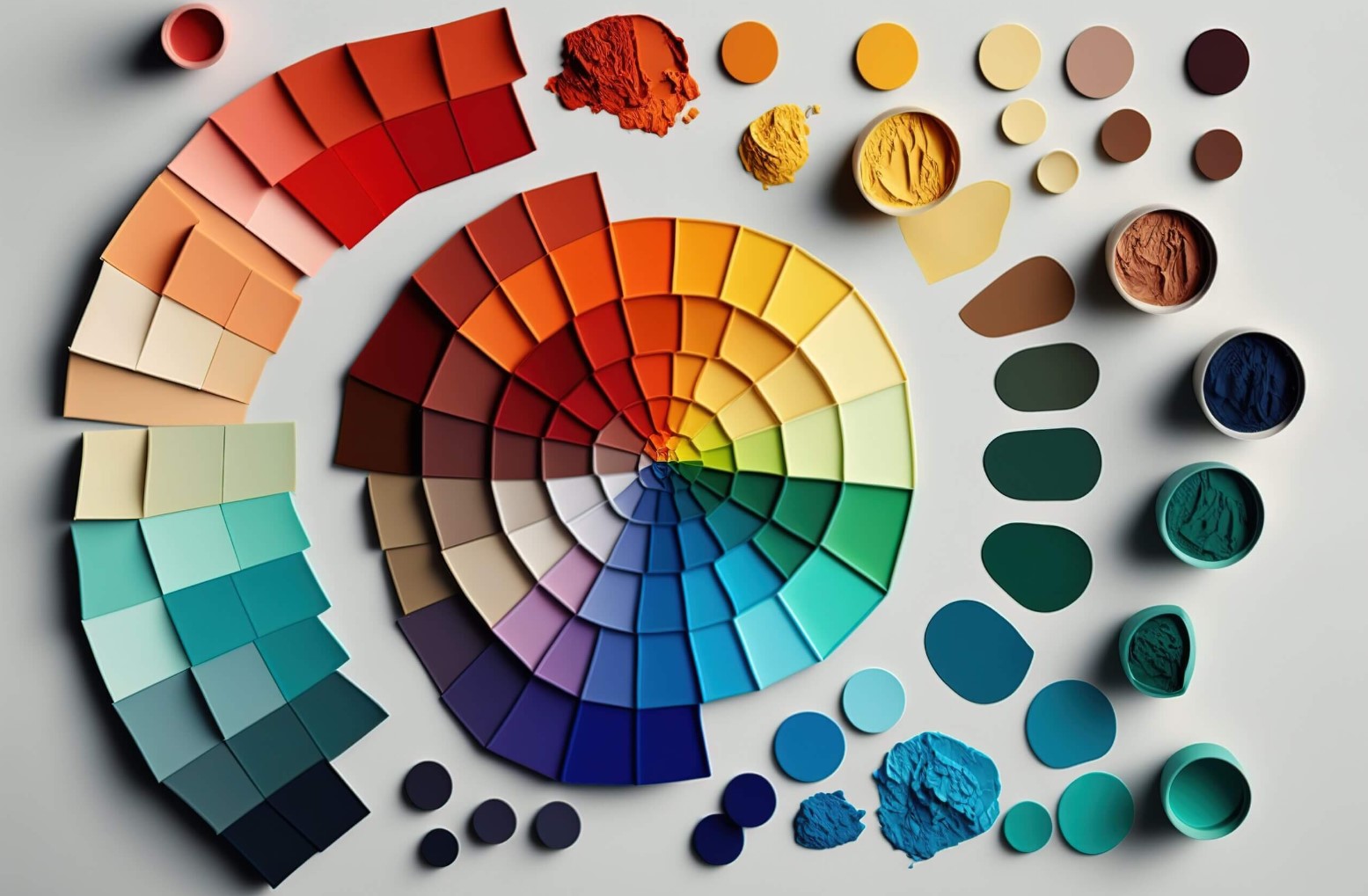Color holds the key to visual storytelling, wielding the power to convey messages without uttering a single word. It shapes perceptions, evokes emotions, and influences decisions. This exploration delves into the essence of color theory, its application in design and marketing, and the psychological impact colors have on our daily interactions.
The Science and Art of Color Theory
Bridging the gap between science and art, color theory provides a structured approach to understanding color’s role in creative and communicative endeavors. Central to this discipline is the color wheel, an ingenious invention by Sir Isaac Newton in the 17th century. This circular diagram elegantly illustrates the relationships and dynamics between colors, serving as a foundational tool for artists and designers alike.
The color wheel begins with the primary colors—red, yellow, and blue—the building blocks of the color spectrum from which all other hues originate. When these primary colors blend, they give rise to the secondary colors: orange, green, and purple, enriching the palette with a diverse range of shades. The creation doesn’t stop there; tertiary colors emerge from the fusion of primary and secondary colors, adding complexity and depth to the spectrum. This intricate dance of hues around the color wheel enables the formulation of countless color schemes, each with its unique ability to evoke specific moods and atmospheres.
Through the lens of color theory, the color wheel transcends its simple appearance, revealing itself as a complex and dynamic tool. It guides the selection of color schemes that are visually appealing and harmonious, ensuring that every palette tells a story, sets a tone, and creates an ambiance. Whether aiming for a serene and calming effect or seeking to energize and excite, designers leverage the color wheel’s principles to achieve their desired outcome.
In the hands of a skilled designer, the color wheel becomes a compass, navigating the vast sea of color possibilities. It helps in identifying complementary colors that offer vibrant contrasts, analogous colors that provide subtle harmony, and triadic colors that promise balanced dynamism. This understanding of color relationships is crucial not just in achieving aesthetic beauty but in crafting designs that communicate effectively and resonate deeply with the audience.
As we delve deeper into the science and art of color theory, we recognize its significance as a fundamental element of visual communication. It’s a testament to the enduring legacy of Newton’s color wheel, a tool that continues to inspire and guide creatives in their quest to harness the transformative power of color.
Harnessing Color in Design and Branding
In the dynamic sphere of design and branding, color emerges as a critical force in crafting a brand’s essence and sculpting its perception among audiences. A meticulously chosen color palette can elevate a brand to iconic status, embedding it in the collective memory of its audience. Conversely, an ill-considered color scheme can diminish its visibility, blending it into the background noise of the marketplace. The artistry lies in curating colors that not only harmonize but also embody the brand’s core attributes and the narratives it seeks to share.
The concept of color appropriateness transcends mere visual pleasure, anchoring itself in the profound alignment between color choices and the brand’s ethos. This congruence ensures that the colors resonate deeply with the intended audience, weaving a stronger emotional bond between the consumer and the brand. Such strategic alignment is pivotal, as it transforms color from a simple design element into a powerful conduit of identity and connection.
The Psychological Dimensions of Color
Delving into the psychological realm, colors wield the power to stir emotions and prompt actions, serving as silent yet persuasive communicators. The color red, with its vibrancy, can spark feelings of passion or signal urgency, making it an effective tool for compelling viewers towards immediate action. In contrast, the serene hues of blue evoke a sense of calm and reliability, qualities that financial institutions often leverage to foster trust among their clients.
Yet, the journey through the color spectrum is deeply personal and culturally conditioned. A color that soothes in one cultural context might unsettle in another, highlighting the intricate dance between color perception and cultural symbolism. This variability accentuates the necessity for designers and marketers to delve into the cultural and personal landscapes of their audience. By doing so, they can tailor their color choices to align with the audience’s expectations and emotional triggers, ensuring that their messages not only reach but resonate with the intended recipients.
In navigating the complex interplay of colors, designers and brand strategists must tread thoughtfully, balancing aesthetic appeal with psychological impact. The choice of colors becomes a dialogue with the audience, a way of bridging worlds and sharing visions. It’s a testament to the power of color to not only capture the eye but to connect with the heart, shaping perceptions and forging emotional bonds that endure. In the hands of a skilled practitioner, color becomes a key that unlocks deeper levels of engagement and understanding, transforming passive viewers into passionate advocates.
Practical Applications and Strategic Considerations
The journey from understanding color theory to its practical application is a nuanced process that demands a blend of creativity and strategic insight. For designers, the challenge extends beyond the realm of selecting harmonious color palettes; it encompasses a deep dive into the psychology of color and its interaction with human perception. This intricate dance involves not just the aesthetics of color combinations but also their functionality within the design. A well-thought-out color strategy can direct the viewer’s gaze, accentuating the most crucial elements of the design and creating a visual hierarchy that guides the audience through the content seamlessly.
Accessibility stands as a cornerstone in the application of color theory, urging designers to adopt a holistic approach to color selection. The goal is to create designs that are not only visually stunning but also universally accessible, including for those with color vision deficiencies. This commitment to inclusivity not only broadens the reach of the design but also underscores a brand’s dedication to accommodating diverse audiences. By employing tools and guidelines designed to enhance color accessibility, designers can ensure that their work resonates with a wider spectrum of viewers, making every interaction meaningful and engaging.
Wrapping It Up
In the vast expanse of design and marketing, color theory emerges as a beacon, guiding creatives through the complexities of visual communication. It is not merely a set of rules but a dynamic framework that adapts to the evolving landscape of design and audience engagement. Mastery of color theory empowers designers and marketers to weave color into the fabric of their creations, transforming it into a powerful narrative tool that speaks directly to the heart.
The strategic use of color transcends aesthetic appeal, becoming a pivotal factor in distinguishing brands in a crowded marketplace. It is the subtle nuances of color selection and application that can elevate a design, turning it into an unforgettable visual experience. As we forge ahead in an era dominated by images and impressions, the thoughtful application of color theory remains a critical element in capturing attention and crafting messages that resonate deeply with audiences.
Color theory is much more than a guide to creating appealing designs; it is a lens through which we can understand the world and our place within it. By harnessing the full potential of color, designers and marketers not only enrich the visual landscape but also connect with audiences on a profound level, bridging gaps and building communities through the universal language of color.





